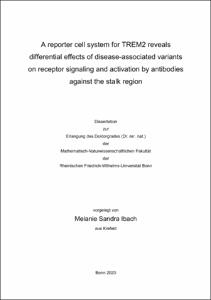A reporter cell system for TREM2 reveals differential effects of disease-associated variants on receptor signaling and activation by antibodies against the stalk region

A reporter cell system for TREM2 reveals differential effects of disease-associated variants on receptor signaling and activation by antibodies against the stalk region

| dc.contributor.advisor | Walter, Jochen | |
| dc.contributor.author | Ibach, Melanie Sandra | |
| dc.date.accessioned | 2021-06-08T06:47:24Z | |
| dc.date.available | 2022-06-15T22:00:27Z | |
| dc.date.issued | 08.06.2021 | |
| dc.identifier.uri | https://hdl.handle.net/20.500.11811/9128 | |
| dc.description.abstract | The triggering receptor expressed on myeloid cells 2 (TREM2) is an immune receptor expressed on myeloid-derived cell types. The extracellular immunoglobulin-like domain of TREM2 binds anionic ligands including Apolipoprotein E (APOE) and Amyloid-ß (Aß). The transmembrane domain interacts with its adaptor protein DAP12/TYROBP that is responsible for propagation of downstream signaling upon ligand interaction. Several sequence variants of TREM2 have been linked to different neurodegenerative diseases including Alzheimer’s disease.
In this study, HEK 293 Flp-In cell lines were generated stably expressing human TREM2 and DAP12 using a bicistronic construct with a T2A linker sequence allowing initial expression of both proteins in stoichiometric amounts. Cell biological and biochemical analyses revealed transport of TREM2 to the cell surface, and canonical sequential proteolytic processing and shedding of TREM2 (sTREM2). Interestingly, the TREM2 G145W variant showed to possibly affect the cleavage and processing by ADAM proteases. Furthermore, the H157Y variant results in a more complex glycosylation as compared to the common variant in the reporter cell system. Using the cell model, we could further demonstrate that TREM2 is mainly degraded via the autophagy-lysosomal pathway. We verified the functionality of this cell system by detection of reactive oxygen species upon challenge with necrotic neural debris as well as by detection of phosphorylated spleen tyrosine kinase (SYK) upon stimulation of TREM2 with the anionic membrane lipid phosphatidylserine or anti-TREM2 antibodies. Using this cell model, we demonstrated impaired signaling of disease associated TREM2 variants. We also identified a monoclonal antibody against the stalk region of TREM2 with agonistic activity that induced phosphorylation of SYK by cross-linking. Activation of TREM2-DAP12 signaling with the monoclonal antibody and the partial loss-of-function of disease associated variants were recapitulated in induced pluripotent stem cell (iPSC) derived microglia. Thus, this reporter cell model represents a suitable experimental system to investigate signaling of TREM2 variants, and for the identification of ligands and compounds that modulate TREM2-DAP12 signaling. | en |
| dc.language.iso | eng | |
| dc.rights | In Copyright | |
| dc.rights.uri | http://rightsstatements.org/vocab/InC/1.0/ | |
| dc.subject.ddc | 570 Biowissenschaften, Biologie | |
| dc.title | A reporter cell system for TREM2 reveals differential effects of disease-associated variants on receptor signaling and activation by antibodies against the stalk region | |
| dc.type | Dissertation oder Habilitation | |
| dc.publisher.name | Universitäts- und Landesbibliothek Bonn | |
| dc.publisher.location | Bonn | |
| dc.rights.accessRights | openAccess | |
| dc.identifier.urn | https://nbn-resolving.org/urn:nbn:de:hbz:5-62578 | |
| ulbbn.pubtype | Erstveröffentlichung | |
| ulbbnediss.affiliation.name | Rheinische Friedrich-Wilhelms-Universität Bonn | |
| ulbbnediss.affiliation.location | Bonn | |
| ulbbnediss.thesis.level | Dissertation | |
| ulbbnediss.dissID | 6257 | |
| ulbbnediss.date.accepted | 05.05.2021 | |
| ulbbnediss.institute | Medizinische Fakultät / Kliniken : Klinik und Poliklinik für Neurologie | |
| ulbbnediss.fakultaet | Mathematisch-Naturwissenschaftliche Fakultät | |
| dc.contributor.coReferee | Witke, Walter | |
| ulbbnediss.date.embargoEndDate | 15.06.2022 | |
| ulbbnediss.contributor.gnd | 1268160172 |
Dateien zu dieser Ressource
Das Dokument erscheint in:
-
E-Dissertationen (4337)




